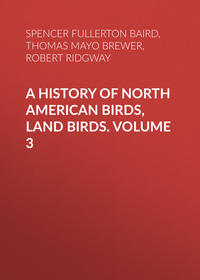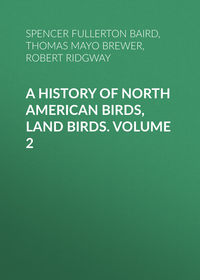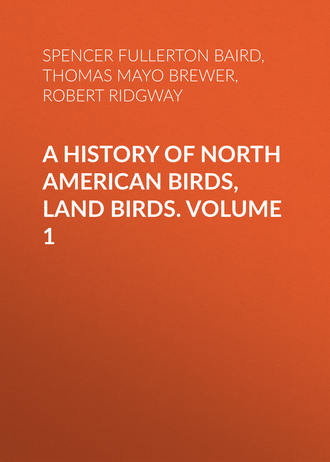 полная версия
полная версияA History of North American Birds, Land Birds. Volume 1
In 1858, Mr. John Cassin wrote me: “The Prairie Warbler certainly breeds in New Jersey, near Philadelphia. I have seen it all summer for the last twelve years, and have seen the young just able to fly, but never found the nest. It has a very peculiar note, which I know as well as I do the Catbird’s, having often followed and searched it out. It frequents cedar-trees, and I suspect breeds in and about them.”
Dr. Coues found the Prairie Warbler mostly a spring and autumn visitant in the vicinity of Washington, being quite abundant during those seasons. A few were observed to remain during the breeding-season. They arrive earlier than most of this family of birds, or about the 20th of April. He found them frequenting, almost exclusively, cedar-patches and pine-trees, and speaks of their having very peculiar manners and notes.
Both Wilson and Audubon were evidently at fault in their descriptions of the nest and eggs. These do not correspond with more recent and positive observations. Its nest is never pensile. Mr. Nuttall’s descriptions, on the other hand, are made from his own observations, and are evidently correct. He describes a nest that came under his observation as scarcely distinguishable from that of the D. æstiva. It was not pensile, but fixed in a forked branch, and formed of strips of the inner bark of the red cedar, fibres of asclepia, and caterpillars’ silk, and thickly lined with the down of the Gnaphalium plantagineum. He describes the eggs as having a white ground, sharp at one end, and marked with spots of lilac-purple and of two shades of brown, more numerous at the larger end, where they formed a ring. He speaks of their note as slender, and noticed their arrival about the second week of May, leaving the middle of September.
At another time Mr. Nuttall was attracted by the slender, filing notes of this bird, resembling the suppressed syllables ’tsh-’tsh-’tsh-’tshea, beginning low and gradually growing louder. With its mate it was busily engaged collecting flies and larvæ about a clump of locust-trees in Mount Auburn. Their nest was near, and the female, without any precautions, went directly to it. Mr. Nuttall removed two eggs, which he afterwards replaced. Each time, on his withdrawal, she returned to the nest, and resorted to no expedients to entice him away.
Several nests of this Warbler have been obtained by Mr. Welch in Lynn. One was built on a wild rose, only a few feet from the ground. It is a snug, compact, and elaborately woven structure, having a height and a diameter of about two and a half inches. The cavity is two inches wide and one and a half deep. The materials of which the outer parts are woven are chiefly the soft inner bark of small shrubs, mingled with dry rose-leaves, bits of vegetables, wood, woody fibres, decayed stems of plants, spiders’ webs, etc. The whole is bound together like a web by cotton-like fibres of a vegetable origin. The upper rim of this nest is a marked feature, being a strongly interlaced weaving of vegetable roots and strips of bark. The lining of the nest is composed of fine vegetable fibres and a few horse-hairs. This nest, in its general mode of construction, resembles all that I have seen; only in others the materials vary,—in some dead and decayed leaves, in others remains of old cocoons, and in others the pappus of composite plants, being more prominent than the fine strips of bark. The nests are usually within four feet of the ground. The eggs vary from three to five, and even six.
The late Dr. Gerhardt found this bird the most common Warbler in Northern Georgia. There its nests were similar in size, structure, and position, but differed more or less in the materials of which they were made. The nests were a trifle larger and the walls thinner, the cavities being correspondingly larger. The materials were more invariably fine strips of inner bark and flax-like vegetable fibres, and were lined with the finest stems of plants, in one case with the feathers of the Great Horned Owl. In that neighborhood the eggs were deposited by the 15th of May.
In Massachusetts the Prairie Warbler invariably selects wild pasture-land, often not far from villages, and always open or very thinly wooded. In Georgia their nests were built in almost every kind of bush or low tree, or on the lower limbs of post-oaks, at the height of from four to seven feet. Eggs were found once as early as the 2d of May, and once as late as the 10th of June. The birds arrived there by the 10th of April, and seemed to prefer hillsides, but were found in almost any open locality.
In Southern Illinois, Mr. Ridgway cites this species as a rather rare bird among the oak barrens where it breeds. He also met with it in orchards in the wooded portions, in April, during the northward migration of the Sylvicolidæ.
The eggs are of an oval shape, pointed at one end, and measure .68 by .48 of an inch. They have a white ground, marked with spots of lilac and purple and two shades of umber-brown.
Subfamily GEOTHLYPINÆ
Section SEIUREÆThe diagnosis of the subfamily will be found on page 178. The Seiureæ, as there stated, have the wings pointed, and rather longer than the nearly even tail, which is unspotted. The genera differ in proportion rather than absolutely, Oporornis having longer wings and larger claws. The coloration, however, is always distinctive, as follows:—
Under part white or whitish, thickly streaked … Seiurus.
Beneath yellow, without spots … Oporornis.
Genus SEIURUS, SwainsonSeiurus, Swainson, Zoöl. Jour. III, 1827, 171. (Sufficiently distinct from Sciurus.) (Type, Motacilla aurocapilla, L.)
Henicocichla, Gray, List of Genera, 1840.
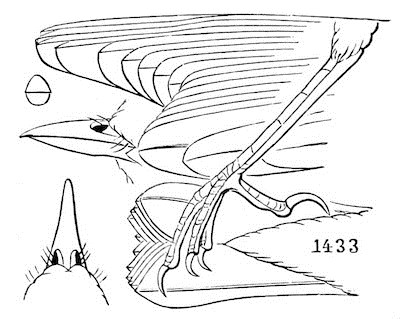
Seiurus aurocapillus.
1433
Gen. Char. Bill rather sylvicoline, compressed, with a distinct notch. Gonys ascending. Rictal bristles very short. Wings moderate, about three quarters of an inch longer than the tail; first quill scarcely shorter than the second. Tail slightly rounded; feathers acuminate. Tarsi about as long as the skull, considerably exceeding the middle toe. Under tail-coverts reaching within about half an inch of the end of the tail. Color above olivaceous; beneath whitish, thickly streaked on the breast and sides. Wings and tail immaculate. Nests on the ground, often arched or sheltered by position or dry leaves. Eggs white, marked with red, brown, and purple.
This genus is decidedly sylvicoline in general appearance, although the spots on the breast resemble somewhat those of the Thrushes. The three species may be grouped as follows:—
A. Middle of crown brownish-orange, bordered by blackish. No white superciliary streak … S. aurocapillus.
B. Crown like the back. A well-defined superciliary light stripe.
Thickly streaked beneath, including crissum. Ground-color and superciliary stripe yellowish. Bill small … S. noveboracensis.
Sparsely streaked beneath; throat and crissum immaculate. Ground-color and superciliary stripe white. Bill very large … S. ludovicianus.
Seiurus aurocapillus, SwainsGOLDEN-CROWNED THRUSHMotacilla aurocapilla, Linn. S. N. I, 1766, 334. Turdus aur. Lath.; Wils. Am. Orn. II, pl. xiv, fig. 2.—Aud. Orn. Biog. II, pl. cxliii. Sylvia aur. Bon. Seiurus aur. Swainson, Zoöl. Jour. III, 1827, 171.—Baird, Birds N. Am. 1858, 260; Rev. 214.—Moore, P. Z. S. 1859, 55 (Honduras).—Max. Cab. Jour. 1858, 177.—Jones, Nat. Bermuda, 27. Henicocichla aur. Sclater, Catal. 1861, 25, No. 159.—Gundlach, Cab. Jour. 1861, 326 (Cuba). Seiurus aur. D’Orb. Sagra’s Cuba, 1840, 55.—Dall & Bannister, Tr. Chic. Ac. I, 1869, 278 (Alaska).—Samuels, 218. Turdus coronatus, Vieill. Ois. II. 1807, 8.
Other localities quoted: Cordova, Sclater, P. Z. S. 1856, 293. St. Domingo, Sallé, P. Z. S. 1857, 231. Guatemala, Sclater & Salvin, Ibis, I, 1859, 10. Santa Cruz (winter), Newton, Ibis, 1859, 142. Cuba (winter), Cab. Jour. III, 471. Jamaica, Gosse, Birds, 152.—Sclater, P. Z. S. 1861, 70. Costa Rica, Cab. Jour. 1861, 84. Orizaba (winter), Sumichrast. Yucatan, Lawr. Chiriqui, Salv.
Sp. Char. Above uniform olive-green, with a tinge of yellow. Crown with two narrow streaks of black from the bill, enclosing a median and much broader one of brownish-orange. Beneath white; the breast, sides of the body, and a maxillary line, streaked with black. The female and young of the year are not appreciably different. Length, 6.00; wing, 3.00; tail, 2.40.
Hab. Eastern Province of North America, north to English River, H. B. T., and Alaska; west to mouth of Platte, and Denver City, Colorado; Mazatlan; whole West Indies; Eastern Mexico; Honduras, Guatemala, and Costa Rica; Bermuda in autumn and winter (Jones).
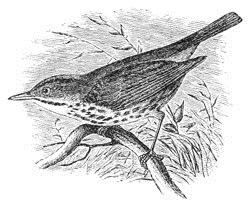
Seiurus aurocapillus.
Habits. The Golden-crowned Thrush, or Oven-Bird, as in some portions of the country it is exclusively called, inhabits the whole of eastern North America, as far to the west as the Great Plains, and to the north at least as far as English River. In the winter season it has been found in Mexico, St. Domingo, Jamaica, Cuba, and other West India islands, and in Central America is also very common. Mr. Sumichrast also speaks of it as common at Orizaba during the same season, and it has been found in the Bermudas and the Bahamas. In all these places it usually appears early in the autumn and remains until the ensuing spring. It breeds as far to the north as it has been known to go. Richardson met with its nest on the banks of the Saskatchewan, and was convinced that it bred at even still higher latitudes. Among some memoranda I received from the late Mr. Kennicott is one stating that he met with this Thrush breeding near English River, July 15. These birds arrive in the fur country about the first of May. How far to the south they breed we have no positive information. I have never received its eggs from any point south of Philadelphia, nor did I ever meet with it or hear its notes in summer in the vicinity of Washington. Audubon was of the opinion that a few remain to breed even in Louisiana, and states that he found them abundant in Texas in the middle of May, but he may have confounded this species with the Louisiana Thrush.
In Jamaica, where its habits have been carefully studied by Mr. Gosse, it arrives in September and leaves about the 20th of April. Mr. Würdemann obtained specimens at Cape Florida, September 24 and 25. Mr. Audubon mentions their appearing in Louisiana as early as the first of March. Wilson never noticed it in Louisiana before the last of April, nor after September. The Smithsonian possesses no specimen obtained earlier than May 1, except some procured April 25 from the mouth of Platte River. Mr. Allen notes its arrival in Western Massachusetts May 10. Mr. Verrill gives the early part of May as the time of its reaching Western Maine, and Mr. Boardman May 1 for the vicinity of Calais.
Though not found on the California coast, specimens of this bird have been taken in winter near Mazatlan, Mexico, showing probably that in their migrations they cross the mountains of Northern Mexico, as do the Mniotilta varia and a few other of our Eastern species.
In Eastern Massachusetts it usually appears from the 1st to the 10th of May, just as the first leaves of the trees are expanding, and is to be found only in thick woods, often near their edges. Occasionally found perched on the low limbs of trees, it is quite terrestrial in its habits, keeps a good deal on the ground, running about among the fallen leaves, more in the manner of a small quadruped than a bird. Mr. Audubon speaks of its frequenting shady woods, watered by creeks and rivulets. I have found them rather more abundant in woods upon high and dry ground, usually upon slopes of wooded hillsides. In this respect it appears to differ in a marked manner from its near of kin, the Water Thrush (S. noveboracensis).
This bird, and indeed all of this genus, have the peculiar vibratory motions of the tail noticed in the Wagtail of Europe, and also observed in our own Red-poll Warbler, and in the Titlarks. In consequence of these peculiarities this species is known, in Jamaica, as Land Kickup, and the noveboracensis as the Water Kickup. Mr. Gosse found in its stomach gravel, various seeds, mud-insects, caterpillars, and small turbinate shells.
The usual and more common song of this species is a very peculiar and striking one, unlike that of any other of our birds. It is said to somewhat resemble the song of the Accentor modularis of Europe. It is loud and clear, enunciated with great rapidity, and uttered with great emphasis at its close. It is characterized by energy and power, rather than variety or sweetness, yet it is not unpleasing. Audubon calls it a “simple lay,” and again “a short succession of simple notes,”—expressions that would give one who had never heard its song an altogether incorrect idea of its true character. Wilson is still more in error when he states that this bird has no song, but an energetic twitter, when, in fact, it has two very distinct songs, each in its way remarkable. Nuttall describes its song as “a simple, long, reiterated note, rising from low to high, and shrill”; Richardson speaks of it as “a loud, clear, and remarkably pleasing ditty”; and Mr. Allen calls it “a loud, echoing song, heard everywhere in the deep woods.” In reference to the songs of this bird, and the injustice that has been done by writers to this and other species of our birds, Mr. Boardman of St. Stephen has written me the following just observations.
“Many of our common Warblers, Thrushes, and other birds, have rare songs they reserve for some extra occasions, and many of our common birds do not get credit for half their real power of song. Once last spring, as I was watching for some birds, I heard a new and very pretty warble, something like the trill of a Winter Wren, and found that it came from our common slate-colored Snowbird (Junco hyemalis), a bird that I see every day that I go to the woods, and yet these notes I had never heard before. It is the same with the Golden-crowned Thrush. When it gets into the top of a tall tree, its strain is so rare and beautiful that but few know it as from that bird. The same is true of the Water Thrush, and also of both Turdus pallasi and Turdus swainsoni.”
The Oven-Bird always nests on the ground, and generally constructs nests with arched or domed roofs, with an entrance on one side, like the mouth of an oven, and hence its common name. This arched covering is not, however, universal. For a site this species usually selects the wooded slope of a hill, and the nests are usually sunk in the ground. When placed under the shelter of a projecting root, or in a thick clump of bushes, the nest has no other cover than a few loose leaves resting on, but forming no part of it.
A nest from Racine, Wis., obtained by Dr. Hoy, is a fine typical specimen of the domed nests of this species. The roof is very perfect, and the whole presents the appearance of two shallow nests united at the rim, and leaving only a small opening at one side. This nest was five inches in diameter from front to back, six inches from side to side, and four inches high. The opening was two and a quarter inches wide, one and three quarters high. The cavity was two inches deep, below the brim. At the entrance the roof recedes about an inch, obviously to allow of a freer entrance and exit from the nest. Externally this nest is made of wood, mosses, lichens, and dry leaves, with a few stems and broken fragments of plants. The entrance is strongly built of stout twigs, and its upper portion is composed of a strong framework of fine twigs, roots, stems, mosses, dry plants, etc., all firmly interwoven, and lined with finer materials of the same.
On the 7th of June, 1858, I came accidentally upon a nest of this bird of a very different style of structure. It was in a thick wood in Hingham. The nest was built in a depression in the ground at the foot of some low bushes, and its top was completely covered by surrounding vines and wild flowers. It would probably have escaped notice had not my daughter, then a child of four years, attempted to gather some wild flowers growing directly over its entrance. This flushed the mother, who until then had remained quiet, although we were standing with our feet almost upon the nest, and the bird fluttered and tumbled about at our feet with well-feigned manœuvres to distract our attention. The child in great glee sought to catch it, but it eluded her grasp, and, running off like a mouse, disappeared. The nest contained six eggs, was entirely open, and with no other cover than the wild plants that clustered above it. As to its identity there was no doubt, as the parent was afterwards snared upon its nest. This nest was somewhat loosely constructed of skeleton leaves, dry slender stalks, grasses, and pine-needles, and was lined with a few slender grasses and leaves. It had a diameter of six inches, and was two and a half inches deep. The cup had a diameter of three and a half inches and a depth of two, being very large for the size of the bird, probably owing to the shape of the cavity in which it was sunk.
The nest of this bird seems to be a favorite place of resort for the Cow Blackbird to deposit its egg. In one nest, found by Mr. Vickary in Lynn, no less than three eggs of these parasites had been placed.
The eggs of the Golden-crowned Thrush are subject to considerable variations. Their markings differ in their colors and shades, and yet more in number, size, and manner of distribution. The eggs are oval in shape, one end being but very slightly smaller than the other. Their average length is .82 of an inch, and their breadth is .55 of an inch. Their ground-color is a beautiful creamy-white. They are marked, usually principally about the larger end, with dots and blotches, intermingled, of red, reddish-brown, lilac, darker purple, and ferruginous. Occasionally these make a beautiful crown around the larger end, leaving the rest of the surface nearly free from spots.
Seiurus noveboracensis, NuttSMALL-BILLED WATER THRUSHMotacilla noveboracensis, Gmelin, S. N. I, 1788, 958. Sylvia nov. Lath.; Vieillot, Ois. Am. Sept. II, pl. lxxxii. Seiurus nov. Nutt.; Bon.; Aud. Birds Am. III, pl. cxcix.—Baird, Birds N. Am. 1858, 261, pl. lxxx, fig. 1; Rev. 215.—Max. Cab. Jour. 1858, 121.—Dall & Bannister (Alaska).—Samuels, 220. Henicocichla nov. Cab. Schom. Guiana, III, 666; Jour. 1860, 324 (Costa Rica).—Sclater (Tobago).—Gundlach, Cab. Jour. 1861, 326 (Cuba). Mniotilta nov. Gray. ?? Motacilla fuscescens, Gmelin, S. N. 984 (based on Ficedula jamaicensis, Brisson, III, 512, Jamaica). Turdus aquaticus, Wils.; Aud. Orn. Biog. 1839, 284, pl. ccccxxxiii. Sylvia anthoides, Vieillot, Nouv. Dict. XI, 1817, 208. Seiurus tenuirostris, Sw. 1827; Gamb. Seiurus sulfurascens, D’Orbigny, Sagra’s Cuba, 1840, 57, pl. vi. Seiurus gosse, Bon. Consp. 1850, 306 (Jamaica). ? Anthus l’herminieri, Less. Rev. Z. 1839, 101 (Colombia).
Other localities quoted: Xalapa, Sclater. Guatemala, Sclater & Salvin. Panama, Lawrence. Carthagena, Cassin. Santa Cruz (winter), Newton. Cuba, Cab. Jamaica, Gosse.; Scl. Venezuela, Scl. & Salv. Yucatan, Lawr. St. Bartholemy, Sund. Veragua, Salv.
Sp. Char. Bill, from rictus, about the length of the skull. Above olive-brown, with a shade of green; beneath pale sulphur-yellow, brightest on the abdomen. Region about the base of the lower mandible, and a superciliary line from the base of the bill to the nape, brownish-yellow. A dusky line from the bill through the eye; chin and throat finely spotted. All the remaining under parts and sides of the body, except the abdomen, and including the under tail-coverts, conspicuously and thickly streaked with olivaceous-brown, almost black on the breast. Length, 6.15; wing, 3.12; tail, 2.40. Bill, from rictus, .64. Sexes similar.
Hab. Eastern Province of North America, north to Arctic Ocean and Yukon (westward along northern border of United States to Cascade Mountains); Fort Bridger, (Drexler); Arizona (Coues); whole West Indies; Southeastern Mexico; all Central America; Panama and Eastern South America (Bogota; Carthagena; Brazil).
A very young bird (22,619, Fort Simpson, August 10) is very different from the adult in coloration. The upper parts are fuliginous-black, each feather with a broad terminal bar of pale ochraceous, wing-coverts tipped with the same, forming two distinct bands; streaks below as in the adult, but broader and less sharply defined.
Habits. This species has a general distribution, at certain seasons, throughout the whole of eastern North America as far to the north as the Arctic Ocean. North of the United States it is also found on the Pacific coast as far south as the Cascade Mountains. In the winter it is quite common in all the West India Islands, in Southeastern Mexico, Central America, Panama, and the eastern part of South America to Brazil. From about latitude 43° northward it breeds throughout all North America. Sir John Richardson met with it at the Carlton House, where it was found frequenting the moist and thickly wooded banks of the river. These birds made their first appearance in May, and the greater portion soon after disappeared, as if proceeding still farther north to breed.
Among other memoranda given me by the late Mr. Kennicott was one furnished him by Mr. Lockhart, to the effect that, at Yukon River, June 21, 1859, he had shot a female Water Thrush as she flew from her nest. This contained five eggs, and was concealed under a small pile of drift, close to the river, but under large willow-trees. This was not lined with down. At the same locality another nest with six eggs was also obtained. This also was on the ground at the foot of some willows near the water. It was made of moss, and lined with very fine grass.
All that has been given by our earlier authors as to the habits of this species must be received with more or less uncertainty. The difference between this bird and that known as the Louisiana Thrush has not been sufficiently clear to these writers to enable us always to determine which of the two they had in view. And even now the distribution in summer of the ludovicianus is hardly definable with precision.
Wilson describes the habits of those he observed in Pennsylvania as evincing a remarkable partiality for brooks, rivers, ponds, and the vicinity of water generally, wading in shallow pools in search of aquatic insects, and giving, as it moves it along, an almost continuously vibratory motion to its tail. He speaks of it as very shy, darting away with signs of alarm whenever approached, and uttering a sharp cry. In all other respects his account of this bird probably refers to the Louisiana species.
This is also, without doubt, true of nearly all Audubon gives in connection with the history of this Thrush, which in all probability does not breed in Louisiana, nor remain there through April, being at that time well on its way to more northern regions.
Mr. Gosse, in his notes on the birds of Jamaica, states that this bird reappears in that island about the end of August. He noticed them about the muddy margins of ponds, and they soon became abundant. Individuals were also to be seen running on the road, especially near the sea-shore, and by the edges of morasses. They ran rapidly, often waded up to their tibiæ in water, or ran along the twigs of a fallen tree at the brink, and now and then flew up into the branches of a pimento or an orange-tree. Whether running or standing, they were continually flirting up their tails, after the manner of the European Wagtail. During its winter residence in Jamaica it has no song, only a monotonous cry, a sharp chip. Its stomach was found to contain water-insects and shells. Mr. March has noticed their arrival in Jamaica as early as August 5. They all leave by the first of April.




